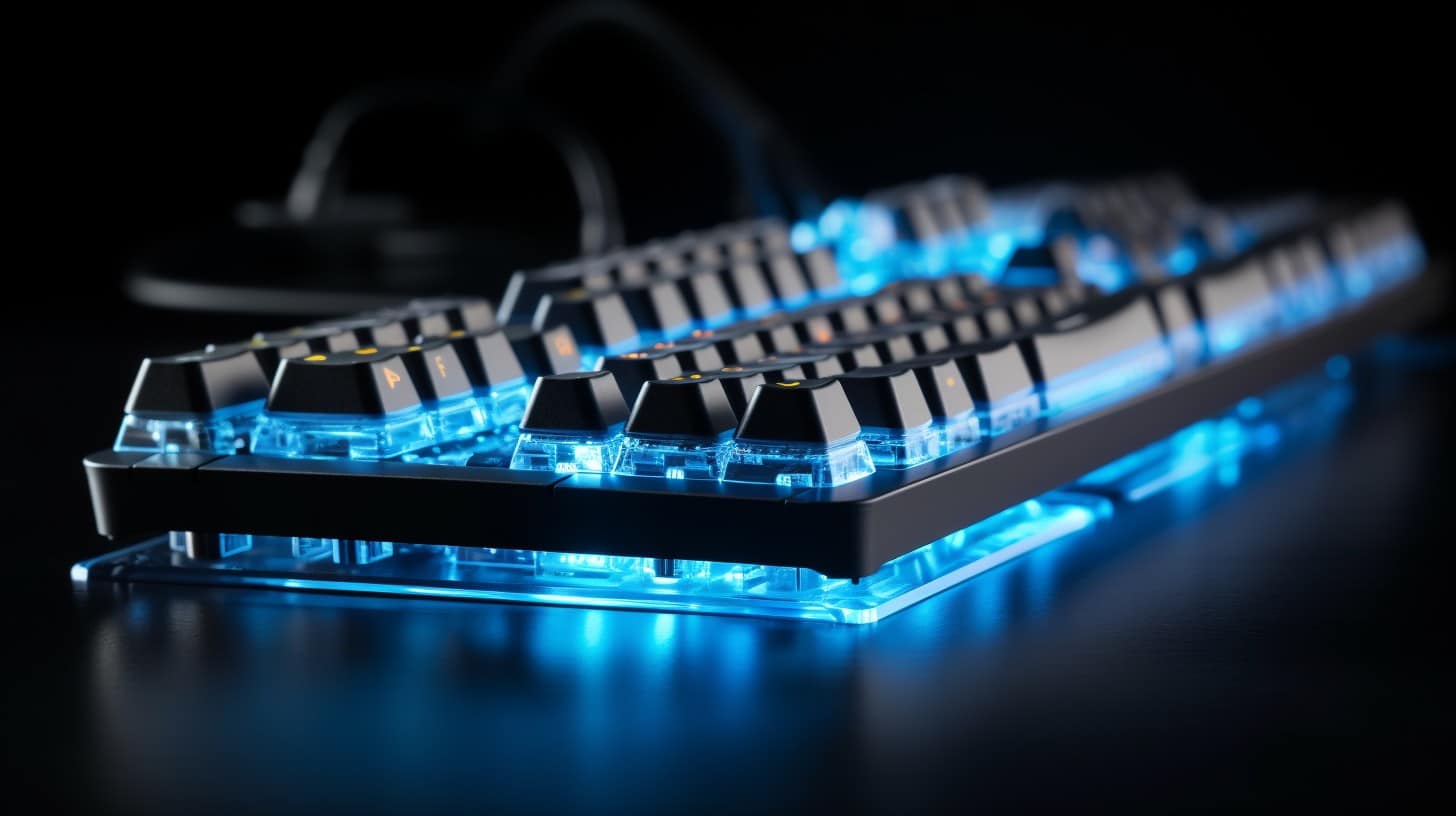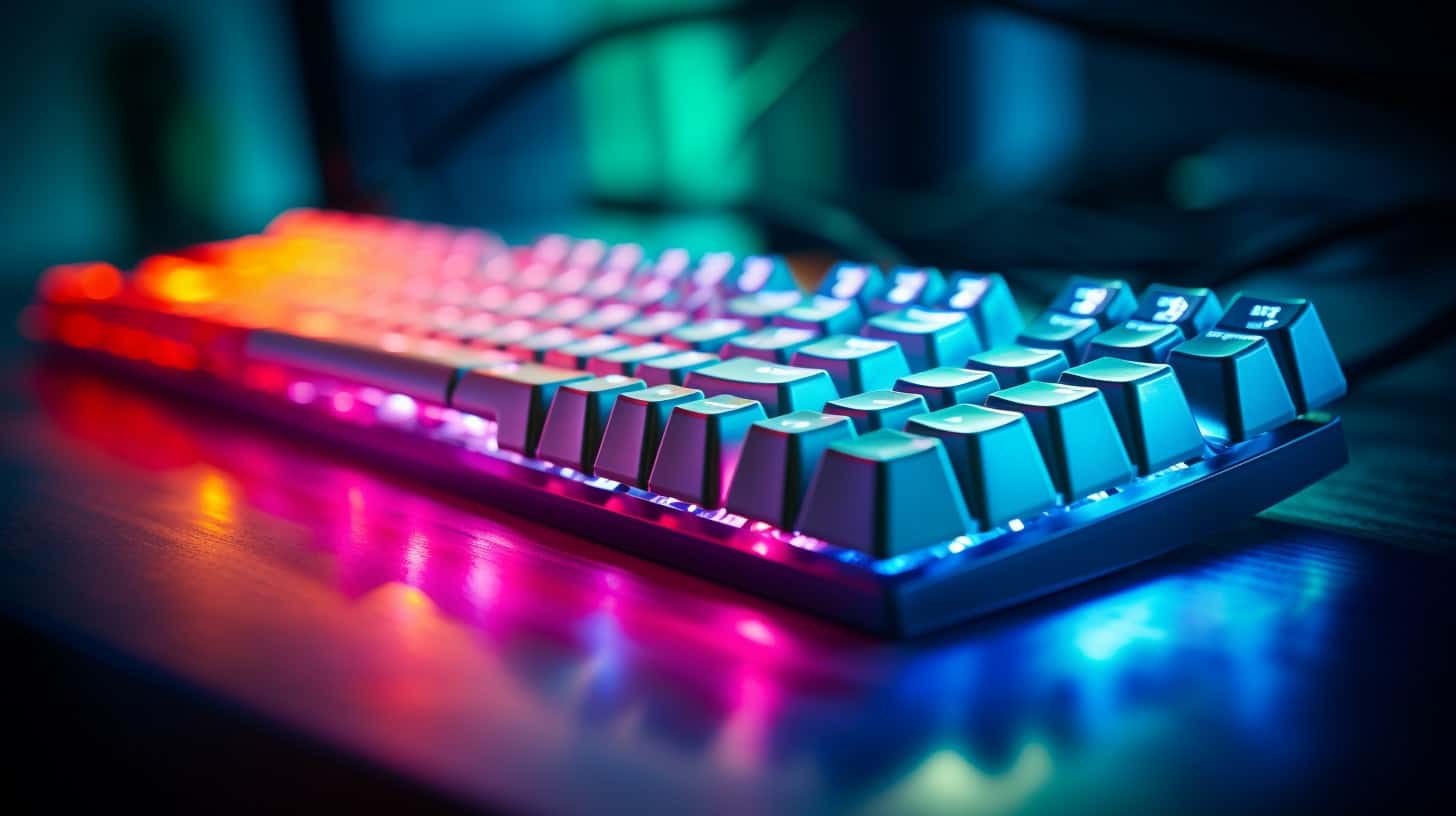Ah, the maddening moment when you’re in full flow typing away, only to realize that some of your keystrokes have vanished into thin air. Yes, I’ve stumbled over this keyboard quirk, too—it goes by the name ghosting.
In this article, we’re going to shed some light on why ghosting occurs and equip you with the strategies to conquer it. So sit tight—soon you’ll be waving goodbye to those pesky keyboard hiccups and hello to seamless typing!
Key Takeaways
Keyboard ghosting is when some keys don’t work if you press many at once.
Good keyboards with ‘n-key rollover’ tech can handle lots of keys pressed together without problems.
You can test your keyboard for ghosting by pressing multiple keys or using online tests and software.
Fix ghosting by getting an anti-ghosting keyboard, remapping keys, and keeping your keyboard clean.
Table of Contents
Exploring the Phenomenon of Keyboard Ghosting

As I delve deeper into the quirks of computer peripherals, there’s this one baffling phenomenon known as keyboard ghosting. It’s that frustrating moment when you’re confidently typing or gaming, and your keyboard somehow fails to register some key presses, or worse, registers additional ones that you didn’t hit.
If you’ve ever experienced your character moving in an unintended direction during a heated game or had extra letters pop up in your Word document out of nowhere, then chances are high that you’ve encountered ghosting.
Understanding what causes these ghostly keystrokes can not only save us from mid-game heartache but also increase our efficiency in every keystroke we make on our trusty keyboards.
What is Keyboard Ghosting?
Keyboard ghosting happens when you press several keys on your computer at once, but not all of them work. Imagine playing a game and trying to move your character with different keys, but they don’t do what they’re supposed to do.
Some letters or commands just won’t show up on the screen—it’s like those key presses have become ghosts! Ghosting is something that can mess up games and make it hard to use quick keyboard shortcuts.
I’ve seen this issue a lot as a gamer. It’s because keyboards are set up in a certain way inside. They have rows and columns that send signals for each key pressed, but if too many are hit at once, the system gets confused.
That means some key presses get ignored—those are the ghost ones. You want every key you hit to count, especially in fast-paced games where timing is everything!
Common Scenarios Leading to Ghosting
Sometimes, I try to press many keys on my keyboard all at once. This is when ghosting happens. It’s like the keyboard gets confused and forgets some of the buttons I hit. The more keys I push at the same time, especially if they’re in different spots, the worse it gets.
Playing fast games or using shortcuts makes ghosting a bigger problem. For example, while gaming, if I need to move and do another action together by hitting several keys quickly, some may not work right.
This can mess up what’s happening in the game because my computer doesn’t see every key that was pushed.
The Mechanics Behind Keyboard Ghosting

Diving into the mechanics behind keyboard ghosting, let’s unravel why our keystrokes sometimes fall into the abyss. The heart of the matter lies in the circuitry of our keyboards—the matrix that assigns a unique signal to each key combination you press.
But here’s where it gets tricky: when several keys are pressed simultaneously, that matrix can get overwhelmed, and certain inputs might be mistakenly ignored or “ghosted.” This ghosting effect primarily occurs because traditional keyboard designs don’t always support simultaneous signals for multiple keys.
To shed more light on this phenomenon, imagine playing a fast-paced game requiring rapid pressing of WASD keys for movement; if your trusty board isn’t equipped with n-key rollover (NKRO) technology, chances are it’ll drop one or two commands in the heat of battle—an absolute no-go for any gaming enthusiast! It turns out that there’s an entire world beneath those plastic caps we tap on day by day—a complex array of printed circuit boards and firmware protocols working tirelessly.
Why Keyboards Experience Ghosting
Keyboards get mixed up sometimes. Think of it like trying to follow three conversations at once – you might miss some words. Keyboards work through a grid called a matrix, which has rows and columns that notice when keys are pushed down.
But if we push too many buttons at the same time in this grid, the keyboard can’t figure out exactly what we want. It might ignore some key presses or think we pressed a button we didn’t.
This happens because keyboards were first made for typing one letter at a time, not for playing fast games with lots of buttons all at once. Games need us to hit keys together quickly to move around or do cool moves, but some keyboards aren’t ready for that kind of action.
They only understand so many keys being pressed all together before they start missing others – that’s ghosting! We’ve got ways to fix it, though, like using better keyboards that can handle more keys being smashed at the same time without getting confused.
The Matrix and Key Rollover
My keyboard has a trick up its sleeve to figure out which buttons I’m pushing. Underneath the keys is a grid called “the matrix.” It has rows and columns that send signals when I press the keys.
But there’s a catch – if I smash too many keys at once, it gets confused. That’s where “key rollover” comes in.
Key rollover is like a superhero for gamers and fast typers. It lets my keyboard keep up with lots of keys hit at the same time without missing any or making mistakes. Most keyboards can handle a few keys, but if two people are using one or someone needs to hit many buttons fast, a big rollover number or even NKRO might be needed so no key gets left behind!
How to Detect and Test for Ghosting

Curious if your keyboard is haunted by the specter of ghosting? There’s a straightforward way to find out. Press and hold several keys simultaneously and observe if any intended keystrokes are not being registered on your screen.
Want a more in-depth analysis? Dive into specific testing programs or utilize websites designed to put your keyboard through its paces, highlighting any ghosting issues that could disrupt your productivity or gaming sessions.
These tools visually display which keys you’re pressing in real-time, making it easy to spot any that fail to respond due to ghosting.
Simple Methods to Check for Ghosting Issues
I’ve had my fair share of ghosting on keyboards, and let me tell you, it’s pretty annoying. But there are some easy ways to test for ghosting issues. Here’s what I do:
- Look for an online ghosting test – You can find these tests easily with a quick search on the internet. They’ll show you if your keyboard is missing keypresses.
- Use testing software – There are programs out there that can tell you if your keyboard has ghosting problems.
- Try the ‘Aqua Key Test‘ – This is a popular tool that lets you press keys on your keyboard to see if any don’t show up on the screen.
- Create your own test in a text document – Hold down multiple keys at once in a blank text file. If all the letters don’t appear, you’ve got ghosting.
- Play a game that requires many keys – Games are where I notice ghosting the most, so try playing one and see if all your commands work.
Solutions to Counteract Keyboard Ghosting

Discover cutting-edge anti-ghosting keyboards and proactive remapping strategies to elevate your typing experience—dive deeper for smooth, uninterrupted gameplay and flawless word processing.
Anti-Ghosting Technology and Keyboards
I love playing fast-paced games that need me to press many keys at once. I used to miss key actions because my keyboard couldn’t keep up. That’s why I switched to an anti-ghosting keyboard.
These keyboards have a special tech inside them. This tech makes sure every key you press gets noticed, even if you smash a bunch of buttons together.
Now, let’s talk about these cool keyboards with anti-ghosting features! They come with something called ‘n-key rollover.’ This means they can handle lots of keys being pressed at the same time without any ghosting.
For gamers or anyone who types like lightning, this is awesome because it catches every move you make. Some of these keyboards handle six keys (6KRO), and others can take all the keys you can press (NKRO).
With anti-ghosting technology, your gaming or typing won’t get messed up anymore!
Tips for Remapping Keys and Improving Keyboard Performance
Remapping keys on my keyboard helps me avoid ghosting and enhances how I play games and use my computer. It takes some time to set up, but once done, it’s like having a custom tool that fits exactly how I work or play. Here’s how to make those changes:
- Look for key remapping software: There are plenty of programs out there that let you assign new functions to your keys. SharpKeys and AutoHotkey are two popular ones.
- Decide which keys to swap: Think about which keys you don’t use much and which ones you hit all the time. For example, if the ‘F’ key is far from reach during a game, switch it with a closer key like ‘Caps Lock.’
- Test your new layout: Play a round of your favorite game or type out an email after remapping. You might need to tweak things a bit until it feels just right.
- Keep the original settings handy: Before making any changes, note down the default settings or create a restore point in case you need to go back.
- Learn hotkeys for your operating system: Knowing shortcuts like ‘Ctrl+C’ for copy can speed up work without pressing many keys at once.
- Try different profiles for tasks: You might want one setup for gaming and another for writing or design work. Some keyboards let you switch profiles on the fly.
- Keep ergonomics in mind: Place important actions on keys that are easy to reach without straining fingers or wrists.
- Regularly clean your keyboard: Dust and debris can cause keys to stick or not register properly.
Now You’ve Got the Knowledge

Understanding keyboard ghosting helps us use our keyboards better. We can pick the right one for gaming or typing fast. It’s great to know we can test and fix ghosting issues ourselves.
With this knowledge, we can enjoy every keystroke and play games at our best!
FAQs About Keyword Ghosting
What does keyboard ghosting mean?
Keyboard ghosting happens when a keyboard doesn’t recognize some key combinations when you press them at the same time.
Why do some of my keyboard buttons not work when I push many at once?
When you press many keys simultaneously, and some don’t work, it’s because of ghosting. It’s due to how the keyboard is made and its communication protocol.
Can I stop ghosting on my wired keyboard?
Yes, getting a wired keyboard with full n-key rollover can fix this because each button works separately.
Will all keyboards have this ghosting problem?
No, not all keyboards have ghosting issues. Keyboards like ones with n-key rollovers or those that use diodes in their hardware design help avoid this problem.
Is there any simple trick to get around ghosting while gaming?
Sometimes, using a PS/2 connection for your wired keyboard instead of USB can improve things, or changing which keys you use for gaming might also help.



